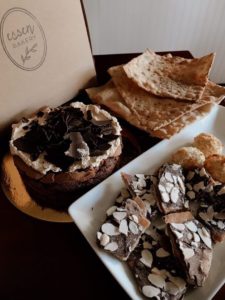
Right about now, the backyards of some Jewish households are becoming five-star restaurants for Philadelphia’s squirrels, birds and deer.
Leavened cookies, cakes and bread buried deep in the pantry are thrown to the wildlife, eliminating the risk of temptation for those observing the upcoming holiday. As Passover approaches, one man’s trash is an animal’s repast.
With the first seder on the 15th of Nisan — or April 15 — on the horizon, marking the first day of Passover, Jews are well into the process of purging their chametz. While some opt to get creative, and others keep to tradition when it comes to their Passover spring cleaning, all observing the holiday are looking to extract the spiritual benefits that abstaining from leavened goods has to offer.
Particularly because avoiding chametz is more than just resisting sandwiches for a week.
While Jews partake in the eating of matzah to commemorate the speed at which our ancestors fled Egypt — so fast that the bread they were baking in preparation didn’t have time to rise — matzah is only a small portion of the Passover dietary strictures.
According to Ko Kosher Service Rabbi Amiel Novoseller, Jews are forbidden by Jewish law to eat five particular grains on the holiday — wheat, barley, spelt, oats and rye — because of their ability to puff up, or become “gebrokts,” when exposed to water.
For some Orthodox Jews, this rules out the possibility of eating matzah ball soup for the pre-brisket appetizer during the seder.
And for Novoseller, keeping things non-gebrokts means being extra cautious with the matzah and grains he has in possession. He won’t fry a piece of matzah in case a small part of it still contains a grain that is holding water that could expand; he argued that keeping wheat flour for making matzah during the holiday is still a no-go for most households, as that flour could have absorbed moisture during production, transit or in the home.
With such uncompromising halachot by which to abide, cleaning one’s house of chametz means getting rid of prohibited foods, but also sweeping, vacuuming and isolating dishes and surfaces that are not kosher for Passover because they have been touched by chametz.
Chabad Rabbi Eli Gurevitz, director of the Rohr Center for Jewish Life, approaches the task with extra urgency. The Haverford-based house is shared with dozens of Jewish students from Bryn Mawr, Haverford and Swarthmore colleges, who attend weekly Shabbat services there, even the week before Passover, where carb-craving young adults count on eating challah.
This year, Gurevitz — and other Orthodox Jews who keep shomer Shabbat — are lucky: Passover starts on a Saturday night, meaning they have a whole week to get rid of any challah.
Still, it’s a six-day turnaround.
“We try to look at it as a labor of love because of what comes after it, when there’s 100 people sitting around the table at the seder,” Gurevitz said.
At this point, Gurevitz and his family have a system down. They vacuum and clean their carpets, cover all surfaces of their kitchen with foil until it “looks like a rocketship” and kosher their sinks with hot water and a hot iron.
“You really only have to clean the areas where there’s a probability or possibility of chametz,” he said.
But for all the cleaning and preparing to rid their house of all their chametz, even a crumb, the Gurevitz family still keep all their chametz in their house, stowed away in a small room and explicitly labeled, so no one accidentally opens the door and snags a snack.

Having chametz in a pantry isn’t the same as having a skeleton in the closet. It’s a practice many Jews abide by over the holiday because of a halachic technicality: One can physically have chametz in their house, as long as they don’t legally own it.
In a twist of classic Jewish loopholes and clever economics, some Jews will sell their chametz to a trusted non-Jew, who legally owned the chametz for the duration of the holiday. When Passover ends, the gentile will then kindly sell the chametz back to their original owners.
On Chabad.org, Jews interested in completing sales can fill out an online form. As long as their chametz are secured in an isolated part of their house and they say the proper blessings, the mitzvah is essentially complete on their end.
In this process, rabbis often act as an agent or power of attorney to oversee the sale. Center City B’nai Abraham Chabad Rabbi Yochonon Goldman oversees the sale of chametz for more than 100 Philadelphia households.
“Even though [chametz] may be physically in your possession, you’re not the legal owner of it,” Goldman said. “You’re leasing the area in your home to a non-Jew for the duration of the holiday.”
Someone’s chametz can sell for a made-up or symbolic number, but the non-Jew really does have to give up some dough for the dough. However, this individual has usually been entrusted with this task for years, and generally receives a little extra during the buy-back sale after the holiday as a thank-you.
For all Jews still wanting to ensure that nothing has been overlooked, a prayer is said the night before Passover to denounce ownership of all chametz.
“At that point, we will say a prayer that anything that we didn’t sell or dispose of would be considered ‘hefker’ or be considered nullified, as if it’s the dust of the earth,” Goldman said. “We don’t want to have any ownership of that.”
Some Orthodox communities will have large bonfires to get rid of chametz and will say this prayer afterward, in case any chametz remains unburned. Technically, a Jew could regain ownership of those chametz after the holiday, but it’s frowned upon, rabbis said.
With the technicalities to consider and labor needed to commit to pre-Passover cleaning, some opt-out of the process, but not as a denouncement of their Jewish values.
For Tova du Plessis, owner of East Passyunk Jewish bakery Essen, keeping a kosher-for-Passover commercial operation is near-impossible when trying to also produce Easter hot cross buns orders for a predominantly non-Jewish neighborhood.
Following kosher laws to a “T” is also just not something du Plessis feels connects her with her Judaism.
“I’m not concerned that I won’t get into the gates of heaven because I’m selling chametz on Passover,” du Plessis said.
Du Plessis is hardly condemning the holiday, however. She’s selling a host of “Passover-friendly” bakes — almond amaretto cake, toffee- and chocolate-covered homemade matzah and coconut-lime macaroons — that don’t use flour or leavening.
Du Plessis still makes the bakery’s homemade matzah in less than 18 minutes — the time it must be created in, start to finish, to be deemed kosher — even though the product itself is not made in a kosher kitchen.
She sets aside an entire afternoon for this process, creating the dough, letting it rest, docking it and baking it quickly, similarly to the way her ancestors made it.

“I can’t think of other food, where the significance of the food is how it’s made. Everything that makes matzah what it is, is how it’s made,” she said. “The whole point is that it was made in a hurry.”
The matzah, as well as the other Passover bakes, are products for people like her and her family: proud and involved Jews who are less interested in observance, but still want to keep to the meaning of the holiday.
“There are many young Jewish families who are just like that,” du Plessis said. “Meaning that even though they don’t feel there’s any sort of requirement to observe in a certain way, they still want to feel very connected to their history, to their ancestry.”






